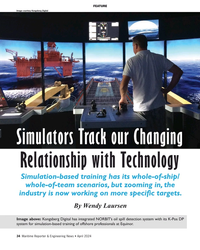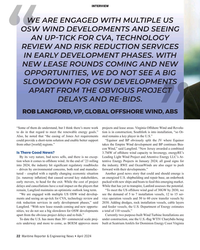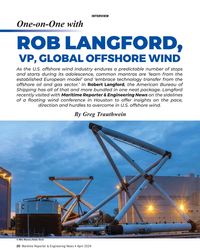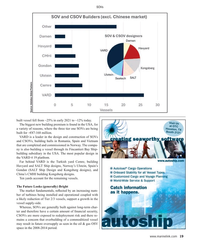Oil Demand
-
- Deepwater Downturn: Bump in the Road or Long-Term Slowing of Growth? Maritime Reporter, Nov 2015 #14
IMA/World Energy Reports has just completed a comprehensiveassessment of the five year outlook for the deepwater sector. The new report – the 19th annual floater market forecast prepared by IMA since 1996 -- provides our forecast of orders for floating production systems between 2016 and 2020. Here’s an overview of the findings and conclusions in the report.
Bottom Line
We see the downturn in market conditions and implosion of Petrobras as a bump in the road. While the outlook is clearly dimmer than last year, there is a large backlog of planned projects requiring floating production systems – and the long term fundamentals to support investment commitment in these projects remain very solid. But the next 12 to 24 months will test the resilience of field operators and contractors in the deepwater supply chain.
The Current Situation
After four decades of rapid growth, the deepwater sector has suddenly stumbled. Very few orders were placed in 2015 for floating production systems. Only 2 FPSOs have been ordered since January of this year– compared to 12+ orders annually over the past decade. The downturn in orders reflects the general unravelling in industry conditions. Virtually every company in the supply chain feels threatened by business softness. Capital expenditures are being sliced and deepwater project starts deferred. Personnel reductions are being announced on a daily basis, rig contracts are being cancelled or renegotiated, assets are being written down.
What happened?
Behind the downturn is an imbalance in oil supply and demand brought on by the emergence of shale/tight oil and inability of major producers to coordinate a ramp-down of global output.A huge oversupply of oil is in the market. The result has been a plummeting of oil prices over the past year --reducing cash flow and prompting oil companies to severely cut back on capital expenditures to conserve cash.
Add to this the implosion within Petrobras. The major player in the deepwater sector has been largely taken off the field by a corruption scandal. More than a third of expected FPSO orders over the next five years were to be generated by Petrobras. But the company’s financial problems have caused a massive cut back in planned project starts. In 2014 Petrobras was planning to acquire13 additionalFPSOs for project starts between 2018/20. Now it is planning to acquire 5 FPSOs – and questions remain about the ability to finance even this reduced number of FPSOs.
Is a Rebound Likely?
Absolutely. Clearly there will be a rebound in the deepwater sector. It will be driven by increasing global oil demand and need to find new sources of oil to replace depleting sources. Global oil demand has been growing at an average rate of 1.4% annually over the past 20 years.With the exception of two years during the global financial meltdown, oil demand has increased year over year during this period.
Looking forward, industry analysts differ on the rate of future oil demand growth, but not on whether growth will continue. For example, the IEA sees world oil demand in 2040 growing to 104 mb/d, an increase of 10 mb/d over current consumption. The EIA predicts global oil/liquid fuel consumption will grow to 119 mb/d by 2040, a 30% increaseover the present. OPEC expects oil demand to grow to 111 mb/d in 2040, up 18% from global oil consumption in 2015.
Among the oil majors, ExxonMobil expects an average growth of 1.2% in oil demand through 2025, followed by a 0.5% growth between 2025 and 2040. BP calls for world oil demand to grow at an average rate of 0.8% annually through 2035. Ultimately new oil sources will be needed to accommodate this demand growth – as well as replace supply losses as depleting oil fields come off line. Deepwater is among those new sources.
What Will Drive the Rebound?
We are tracking more than 240 offshore oil and gas projects in the planning stage that likely require a floating production system for development.Some of these projects will require multiple systems. If all projects proceed to development, up to 275 new production floaters will be required over the next 10 to 15 years. A large backlog of eligible projects is significant – but only part of the picture in forecasting future production floater orders. Ultimately an investment decision is needed to transform these deepwater project opportunities into contracts for floating production facilities. In our forecast report we examine eleven underlying business drivers that will influence the timing and direction of future deepwater project investment decisions. Here’s how we see these eleven drivers at the moment.
In the positive category are
• Oil and gas demand keeps growing
• Supply disruption potential keeps the focus on finding new sources of supply
• Long term oil/gas prices will rise, driven by demand/supply fundamentals
In the negative category are
• Near term oil and gas prices have fallen to levels that discourage investment
• Major energy companies have been cutting back on capital expenditures
• More supply has suddenly come into the oil and gas market
• Shale/tight oil and gas projects are competing for investment funds
• Local content constraints in the supply chain are creating delays and overruns
• Petrobras, the major customer, is having serious financial problems
• Cost of capital for deepwater projects will rise over the next several years
In the unknown category are
• Black swan events can (and have) disrupt the sector
Interaction of these drivers over the next few years will determine the number and timing of future production floater orders.
Forecast for Orders
In the most likely scenario, over the next five years we expect orders for 64 oil/gas production units (FPSOs, Semis, Spars and TLPs), 29 LNG processing units (FLNGs, FSRUs) and 25 storage/offloading units (FSOs). Capex associated with the building and conversion contracts will be in the vicinity of $106 billion. A breakdown of the forecast by size unit, region, year order placed, new or modified hull, etc. is provided in the new report.
In the high scenario we anticipate a considerably stronger pace of orders. Here we expect orders for 77 oil/gas production floaters, 36 LNG processing units and 30 storage/offloading units. In the low scenario the number of orders is expected to be 45 oil/gas production floaters, 22 LNG processing units and 20 storage/offloading units.
The 2016/20 forecast is significantly lower than the five year forecast last year. There we projected orders for 98 oil/gas production units, 25 LNG processing units and 30 storage/offloading units. .
Details for the production floater forecast are provided in our new 186 page report. Information about the report, including the table of contents and list of exhibits, is available at
www.worldenergyreports.com(As published in the November 2015 edition of Maritime Reporter & Engineering News - http://magazines.marinelink.com/Magazines/MaritimeReporter)
-
- Floating Production System Orders Outlook Maritime Reporter, May 2014 #12
spending budgets and deepwater drillers are not quite as bullish as in recent past. Growing Demand for Oil and Gas On the positive side, global oil demand has grown at an average rate of 1.4% annually over the past 20 years. With the exception of two years during the global financial meltdown, oil
-
- GOM: Number Of Floating Production Systems Projected To Rise Maritime Reporter, Jul 2000 #36
2000. The Drivers Oil market fundamentals continue to strengthen. The outlook for world economic growth continues to be good, forecasts call for oil demand to increase and the oil producers appear to have engineered a soft landing for oil prices. According to the IMF, the world economy in 2000 will
-
- Will Oil Continue Heading Up? Maritime Reporter, Jun 2004 #34
from a number of new studies on oil, gas and renewable energy published by his firm, Westwood said, "Any growth in global economic activity increases oil demand such that at 1% demand growth a production peak occurs in 2016. at 2% it occurs in 2012, and at 3% it occurs in 2008. "The world's known and
-
- Local Yards Start To Feel The Impact Maritime Reporter, Jul 2001 #26
marine business in the GOM region is a prosperous one. While a recent (May 11, 2001) report from the International Energy Agency notes that global oil demand has dipped in recent months, a look at the big picture shows that global oil demand has grown from 74.8 million barrels per day in 1999 to 76
-
- OMI Announces 1Q Results Maritime Reporter, Jun 2002 #47
as well as low natural gas prices, and thus lack of natural gas for oil substitution, resulted in an additional reduction of about 0.9 million bpd in oil demand compared to the same period a year ago." Scrapping activity has recently picked up and is presently at a 30,000,000 dwt annualized rate. While
-
- Teekay Sees Amended Regs as Positive Maritime Reporter, Jan 2004 #12
tonnage. The accelerated phase-out of 12 percent of the world tanker fleet over the next two years coupled with the forecasted increase in global oil demand should offset the current tanker orderbook. As a result, we expect the current tight balance between tanker supply and demand to continue during
-
- Cautious Consolidation for OSV Companies Brings Market Change Marine News, Nov 2018 #30
will be around for a long time. Over the longer term, measured in decades, the Class Society DNV GL, in its 2018 Energy Transition Outlook, says that: “Oil demand will peak in the 2020s and natural gas will take over as the biggest energy source in 2026.” They added, “Existing fields will deplete at a faster
-
- Greasing the Skids Maritime Reporter, Jun 2001 #56
down. In the latest Oil Market Report dated May 11, 2001 from the International Energy Agcncy (IEA), the organization notes that first quarter 2001 oil demand appears to have fallen short of expectations by more than a half million barrels of oil per day, yet still grew at 1.1 mb/d. Meanwhile, world oil
-
- Shale Oil Is it a Threat to Future Deepwater Development? Maritime Reporter, Sep 2013 #12
drivers for deepwater development point toward continued sector growth. Spot and futures crude pricing is at levels supporting deepwater development. Oil demand keeps growing and there continues to be need for new future sources of oil. The threat of supply disruption from traditional sources remains, prompting
-
- BY THE NUMBERS - Offshore Supply Vessels: Balanced Continued Pressure with Gradual Recovery Marine News, Nov 2018 #10
, geopolitical factors and U.S. oil infrastructure issues aside, abundant shale oil supplies in the near term and the impact of energy transition on oil demand in the medium-to-long term will likely serve as constraints on drilling a substantial number of new offshore wells.Given these structural shifts
-
- The New Offshore Reality Maritime Reporter, May 2017 #50
industry afloat, collectively they assess Swedbank’s chief economist, Harald Andreassen, isn’t “too hopeful” about the long-term prospects for the oil price, but then again, “I’m less certain of this than I’ve ever been as an economist,” he told a floating production conference in Oslo. After two-and-half
-
 )
March 2024 - Marine Technology Reporter page: 42
)
March 2024 - Marine Technology Reporter page: 42versions Image courtesy Kongsberg Discovery are featured in the series, and all withstand reverse pressure, too, and can be installed into both dry and oil-? lled canisters. MacArtney introduced a space and weight-saving ø12.7 mm SubConn Nano, a Nano connector which offers a versatile and robust performance
-
 )
March 2024 - Marine Technology Reporter page: 39
)
March 2024 - Marine Technology Reporter page: 397 A 35Ah AGM lead-acid battery is tested using the West Mountain Radio CBA to show the effect of simply ? lling the battery voids with mineral oil as a compensating ? uid. The CBA is programmed to cut-off at a voltage of 10.50v. The top line (red) shows the unmodi? ed AGM battery capacity of
-
 )
March 2024 - Marine Technology Reporter page: 36
)
March 2024 - Marine Technology Reporter page: 36, Thus, there are no implodable spaces, and so are candidate and UPS, have speci? c guidelines available on their websites. cells for pressure-balanced, oil-? lled (PBOF) assemblies. This author has personally tested pouch LiPos to 20,000 psi im- Lead-Acid: The venerable lead-acid battery comes in three
-
 )
March 2024 - Marine Technology Reporter page: 35
)
March 2024 - Marine Technology Reporter page: 35.com/BPD.htm). have been tested ? Alkaline (alkaline-manganese dioxide): These prima- ry cells are available in the widest number of standard sizes, in oil-? lled bags and are commonly available around the world. This is handy to pressures of 20,000psi without if you are in a remote port and need
-
 )
March 2024 - Marine Technology Reporter page: 33
)
March 2024 - Marine Technology Reporter page: 33in the world.” How- ever, commercial success depends on many factors, not least a predictable OPEX. Over the past four years, SMD has worked with Oil States Industries to calculate cost per tonne ? gures for prospective customers. Patania II uses jet water pumps to Oil States’ Merlin riser systems
-
 )
March 2024 - Marine Technology Reporter page: 29
)
March 2024 - Marine Technology Reporter page: 29n January, Norway said “yes” to sea- bed mining, adding its weight to the momentum that is likely to override the calls for a moratorium by over 20 countries and companies such as I Google, BMW, Volvo and Samsung. Those against mining aim to protect the unique and largely unknown ecology of the sea?
-
 )
March 2024 - Marine Technology Reporter page: 17
)
March 2024 - Marine Technology Reporter page: 17• Integrity assessment, and otherwise covered, e.g., by rock dump. As for depletion of • Mitigation, intervention and repair. sacri? cial anodes, this can be dif? cult or even impossible to Selecting the best method for collecting the data these work- estimate due to poor visibility, the presence of
-
 )
March 2024 - Marine Technology Reporter page: 13
)
March 2024 - Marine Technology Reporter page: 13nyone familiar with glider hardware options integrated for a broad Glider answers that need,” said Shea autonomous underwater ve- range of missions. Quinn, Slocum Glider Product Line hicles (AUVs) is certainly “As the use of Slocum Gliders grew, Manager at TWR. A familiar with the popular- so did
-
 )
April 2024 - Maritime Reporter and Engineering News page: 47
)
April 2024 - Maritime Reporter and Engineering News page: 47.com Powering the fleet for 60 years! HYDRAULIC NOISE, SHOCK AND VIBRATION SUPPRESSOR Noise, Shock, VibraO on & PulsaO on in Quiet, Smooth Flow Out Oil Bladder Nitrogen (blue) Manufactured by MER Equipment Three Stage Noise & PulsaO on in ReducO on Chamber (206) 286-1817 www.merequipment.com QUALITY
-
 )
April 2024 - Maritime Reporter and Engineering News page: 43
)
April 2024 - Maritime Reporter and Engineering News page: 43“The industry is an ecosystem which includes owners, managers, mariners, shipyards, equipment makers, designers, research institutes and class societies: all of them are crucial,” – Eero Lehtovaara, Head of Regulatory & Public Affairs, ABB Marine & Ports All images courtesy ABB Marine and Ports provi
-
 )
April 2024 - Maritime Reporter and Engineering News page: 41
)
April 2024 - Maritime Reporter and Engineering News page: 41maritime environments: • GMDSS/NAVTEX/NAVDAT coastal surveillance and transmission systems • Offshore NDB non-directional radio beacon systems for oil platform, support vessel & wind farm applications • DGPS coastal differential global positioning systems • VHF port communication systems Nautel
-
 )
April 2024 - Maritime Reporter and Engineering News page: 40
)
April 2024 - Maritime Reporter and Engineering News page: 40TECH FEATURE SITUATIONAL AWARENESS SITUATIONAL AWARENESS SYSTEM BATTLES COGNITIVE FATIGUE IN WATCHKEEPERS All images courtesy Groke Technologies Today’s evolving maritime security risks pose all-too-familiar threats to international shipping, and as just one of the many causes of fatigue, they add
-
 )
April 2024 - Maritime Reporter and Engineering News page: 39
)
April 2024 - Maritime Reporter and Engineering News page: 39Tech Files Latest Products, Systems and Ship Designs “Wall Climbing Robot” Danish Pilot calls gets ClassNK Nod LEGO Model "A tribute build to a work life at sea" Image courtesy MOL, Sumitomo Heavy Industries lassNK granted its Innovation Endorse- Image courtesy Espen Andersen/DanPilot ment for
-
 )
April 2024 - Maritime Reporter and Engineering News page: 38
)
April 2024 - Maritime Reporter and Engineering News page: 38, including collecting MARPOL liquid The tanker vessel Archangel, 274 meters long and 85,474 and solid waste, transporting personnel and provisions, and oil gt, was moored using the 3-ton pulling capacity of the moor- spill response services. Images courtesy Consulmar Crowley's New LNG Containerships Carbon
-
 )
April 2024 - Maritime Reporter and Engineering News page: 35
)
April 2024 - Maritime Reporter and Engineering News page: 35becoming as interconnected as onboard sys- size training materials, including micro-learning videos, gam- tems. Kongsberg Digital has integrated NORBIT’s oil spill ing apps, VR programs and online mentoring. detection system with its K-Pos DP system for simulation- “These digital methods are more effective
-
 )
April 2024 - Maritime Reporter and Engineering News page: 34
)
April 2024 - Maritime Reporter and Engineering News page: 34scenarios, but zooming in, the industry is now working on more speci? c targets. By Wendy Laursen Image above: Kongsberg Digital has integrated NORBIT’s oil spill detection system with its K-Pos DP system for simulation-based training of offshore professionals at Equinor. 34 Maritime Reporter & Engineering
-
 )
April 2024 - Maritime Reporter and Engineering News page: 32
)
April 2024 - Maritime Reporter and Engineering News page: 32? xed wind. The subsidies won’t be a plentiful, and then a second on a luf? ng jib. This reduces the time it would there won’t be the same downturn in oil and gas that made all ordinarily take, weeks, to recon? gure the wiring of an ordi- the high-spec construction vessels available at attractive rates
-
 )
April 2024 - Maritime Reporter and Engineering News page: 25
)
April 2024 - Maritime Reporter and Engineering News page: 25vessels can MSC will see up to 20 new ships deliver to carry the equivalent of 30 C-17 transports. the ? eet in the next ? ve years. This includes new oil- Our Combat Logistics Force (CLF) is the key to keep- ing our ships at sea and in the ? ght, and sustain our forces ers, towing, salvage and rescue
-
 )
April 2024 - Maritime Reporter and Engineering News page: 22
)
April 2024 - Maritime Reporter and Engineering News page: 22INTERVIEW WE ARE ENGAGED WITH MULTIPLE US OSW WIND DEVELOPMENTS AND SEEING AN UP-TICK FOR CVA, TECHNOLOGY REVIEW AND RISK REDUCTION SERVICES IN EARLY DEVELOPMENT PHASES. WITH NEW LEASE ROUNDS COMING AND NEW OPPORTUNITIES, WE DO NOT SEE A BIG SLOWDOWN FOR OSW DEVELOPMENTS APART FROM THE OBVIOUS
-
 )
April 2024 - Maritime Reporter and Engineering News page: 21
)
April 2024 - Maritime Reporter and Engineering News page: 21along with our continued support to the in a UK design ? rm working in the North Sea marine industry,” said Langford. “We continue to hire key in- oil and gas platforms, the holy grail of rigorous dividuals and partner to provide best-in-class solutions.” R conditions in offshore energy production
-
 )
April 2024 - Maritime Reporter and Engineering News page: 20
)
April 2024 - Maritime Reporter and Engineering News page: 20and starts during its adolescence, common mantras are ‘learn from the established European model’ and ‘embrace technology transfer from the offshore oil and gas sector.’ In Robert Langford, the American Bureau of Shipping has all of that and more bundled in one neat package. Langford recently visited
-
 )
April 2024 - Maritime Reporter and Engineering News page: 19
)
April 2024 - Maritime Reporter and Engineering News page: 19more exposed to redeployment risk and there re- mains a concern that overbuilding of a commoditized vessel may result in future oversupply as seen in the oil & gas OSV space in the 2008-2014 period. www.marinelink.com 19 MR #4 (18-33).indd 19 4/5/2024 8:13:37 A
-
 )
April 2024 - Maritime Reporter and Engineering News page: 18
)
April 2024 - Maritime Reporter and Engineering News page: 18through dual fuel near shore Taiwanese market, which is also actively served by engines and (space for) a bunkering system. Currently metha- CTVs. Oil & gas offshore support vessels have been widely nol is a preferred energy carrier although hydrogen and liquid deployed to support construction logistics
-
 )
April 2024 - Maritime Reporter and Engineering News page: 17
)
April 2024 - Maritime Reporter and Engineering News page: 17or under construction in the North Euro- pean wind segment. Tier 2 and Tier 3 walk-to-work (W2W) vessels are cur- rently active in the segment, but as oil www.marinelink.com 17 MR #4 (1-17).indd 17 4/5/2024 8:40:33 A
